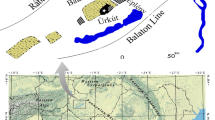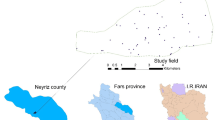Abstract
Even though the use of uranium mill tailings as a construction material is prohibitive such prototype dwellings can be constructed for developing models for the human exposure assessment. Among the potential challenges of uranium mill tailings build-up of radon (222Rn) from the tailings pile and subsequent migration following dispersion is assumed significance due to the associated inhalation hazard of its progeny. Sources of such exposure are predominantly considered as the 226Ra (parent of 222Rn) present in the construction material and underlying geophysical characteristics. In the present investigation, a model is developed presuming the use of mill tailings as the construction material of a dwelling (prototype). The numerical model prediction for 1.14 Air Changes per Hour (ACH) reflects that the level can be approximated at 300 Bq m−3, a reference level proposed in ICRP recommendation (ICRP 2014).



Similar content being viewed by others
References
Ishimori Y, Lange K, Martin P, Mayya YS, Phaneuf M (2013) Measurement and calculation of radon releases from NORM residues. Technical reports series, ISSN 0074–1914; no. 474
Usnrc Regulatory Guides (1989) Calculation Of Radon Flux
Attenuation by earthen uranium mill tailings covers. Regulatory guide 3.64 (Task WM 503–4)
Rogers VC, Nielson KK, Kalkwarf DR (1984) Radon attenuation handbook for uranium mill tailings covers design (No. NUREG/CR-3533; PNL-4878; RAE-18-5). Rogers and Associates Engineering Corp., Salt Lake City, UT (USA).
Chauhan N, Chauhan RP, Joshi M, Agarwal TK, Aggarwal P, Sahoo BK (2014) Study of indoor radon distribution using measurements and CFD modeling. J Environ Radioact 136:105–111
Cosma C, Cucoş-Dinu A, Papp B, Begy R, Sainz C (2013) Soil and building material as main sources of indoor radon in Băiţa-Ştei radon prone area (Romania). J Environ Radioact 116:174–179
Sabbarese C, Ambrosino F, D’Onofrio A (2021) Development of radon transport model in different types of dwellings to assess indoor activity concentration. J Environ Radioact 227:106501
UNSCEAR (2019) Sources, effects and risks of ionizing radiation.
IAEA (2014) Radiation protection and safety of radiation sources: international basic safety standards
Lecomte JF, Solomon S, Takala J, Jung T, Strand P, Murith C, Janssens A (2014) ICRP publication 126: radiological protection against radon exposure. Ann ICRP 43(3):5–73
Antignani S, Venoso G, Ampollini M, Caprio M, Carpentieri C, Di Carlo C, Caccia B, Hunter N, Bochicchio F (2021) A 10-year follow-up study of yearly indoor radon measurements in homes, review of other studies and implications on lung cancer risk estimates. Sci Total Environ 762:144150
Maier A, Wiedemann J, Rapp F, Papenfuß F, Rödel F, Hehlgans S, Gaipl US, Kraft G, Fournier C, Frey B (2020) Radon exposure—therapeutic effect and cancer risk. Int J Mol Sci 22(1):316
Yarmoshenko IV, Malinovsky GP (2020) Combined analysis of onco-epidemiological studies of the relationship between lung cancer and indoor radon exposure. Nukleonika 65(2):83–88
Kang JK, Seo S, Jin YW (2019) Health effects of radon exposure. Yonsei Med J 60(7):597–603. https://doi.org/10.3349/ymj.2019.60.7.597
Khan SM, Chreim S (2019) Residents’ perceptions of radon health risks: a qualitative study. BMC Public Health 19(1):1–11. https://doi.org/10.1186/s12889-019-7449-y
Choi J, Hong H, Lee J, Kim S, Kim G, Park B, Lee C (2022) Comparison of indoor radon reduction effects based on apartment housing ventilation methods. Atmosphere 13(2):204
Cucoş A, Cosma C, Dicu T, Papp B, Horju-Deac C (2015) Ventilation systems for indoor radon mitigation in energy-efficient houses. Ecoterra—J. Environ Res Prot 12:14–20
Akbari K, Mahmoudi J (2018) Simulation of radon mitigation in residential building with ventilation. In: Proceedings of SIMS, vol 49, pp 177–183
Tukkaraja P, Bhargava R, Sridharan SJ (2021) Radon in underground mines. In: Mining technology. IntechOpen
Joseph S (2023). Radon—mitigatory and control measures. In: Environmental radon: a tracer for hydrological studies. Springer Nature Singapore, Singapore, pp 167–184
Sharma A, Mahur AK, Yadav M, Sonkawade RG, Sharma AC, Ramola RC, Prasad R (2015) Measurement of natural radioactivity, radon exhalation rate and radiation hazard assessment in Indian cement samples. Phys Procedia 80:135–139
Oluyide SO, Tchokossa P, Akinyose FC, Orosun MM (2019) Assessment of radioactivity levels and transfer factor of natural radionuclides around iron and steel smelting company located in Fashina village, Ile-ife, Osun state, Nigeria. Facta Universitatis, series: working and living environmental protection, pp 241–-256
de Aquino RR, Pecequilo BRS (2015) Activity concentrations of natural radionuclides in commercial granite samples from Espirito Santo State Brazil. Int Nucl Safe J 4(3):53–58
Ozden B, Guler E, Vaasma T, Horvath M, Kiisk M, Kovacs T (2018) Enrichment of naturally occurring radionuclides and trace elements in Yatagan and Yenikoy coal-fired thermal power plants, Turkey. J Environ Radioact 188:100–107
Sas Z, Doherty R, Kovacs T, Soutsos M, Sha W, Schroeyers W (2017) Radiological evaluation of by-products used in construction and alternative applications; Part I. Preparation of a natural radioactivity database. Constr Build Mater 150:227–237
Eriksson G, O’Hagan LA (2021) Selling “Healthy” radium products with science: a multimodal analysis of marketing in Sweden, 1910–1940. Sci Commun 43(6):740–767
Takibai S, Sakanov K, Sungidmaa D (2020) Analysis of radio activity and thermal decomposition of fly ash for application in light concrete production. In IOP conference series: materials science and engineering. IOP Publishing, vol 953, No. 1, p 012068
Paredes CH, Kessler WV, Landolt RR, Ziemer PL, Paustenbach DJ (1987) Radionuclide content of and 222Rn emanation from building materials made from phosphate industry waste products. Health Phys 53(1):23–29
Lecomte JF, Shaw P, Liland A, Markkanen M, Egidi P, Andresz S et al (2019) ICRP publication 142: radiological protection from naturally occurring radioactive material (NORM) in industrial processes. Ann ICRP 48(4):5–67
Naturally-Occurring Radioactive Materials (NORM). https://world-nuclear.org/information-library/safety-and-security/radiation-and-health/naturally-occurring-radioactive-materials-norm.aspx . Accessed 04 Jun 2023
Collier D (2016) Uranium mine and mill remediation and reclamation. In: Uranium for nuclear power. Woodhead Publishing, pp 415–437
The long term stabilization of uranium mill tailings. https://www-pub.iaea.org/MTCD/Publications/PDF/te_1403_web.pdf . Accessed 05 Jun 2023
Ma W, Gao B, Guo Y, Sun Z, Zhang Y, Chen G, Zhu X, Zhang C (2020) Occurrence and distribution of uranium in a hydrological cycle around a uranium mill tailings pond, Southern China. Int J Environ Res Public Health 17(3):773
Standard Room Sizes and Room Area—Detailed Information. https://civilsite.in/standard-room-sizes-and-area/ Accessed 28 Jan 2023
Report On Soil Resources Map Of East Singhbhum District Jharkhand State https://jsac.jharkhand.gov.in/Report_PDF/New_Soil_Report/soil_e_singhbhum.pdf Accessed 04 Jan 2023
Ob WL, DeLand SM, Rutherford BM, Diegert KV, Alvin KF (2000) Estimation of total uncertainty in modeling and simulation. Sandia Report SAND2000–0824, Albuquerque, NM, 56
Standard Brick Size in India https://civilplanets.com/brick-size-in-india/ Accessed 28 Jan 2023
What is the standard slab thickness for residential building? https://www.nobroker.in/forum/what-is-the-standard-slab-thickness-for-residential-building/ Accessed 28 Jan 2023
Saptaningtyas FY, Setyarsi AD (2018) Finite volume method with explicit scheme technique for solving heat equation. In: Journal of physics: conference series. IOPPublishing, vol 1097, No 1, p 012089
Finite volume solution of the heat conduction equation—an application in 3D.
https://www.researchgate.net/publication/343981876_Finite_Volume_Solution_of_the_Heat_Conduction_Equation_-An_Application_in_3D. Accessed 21 Apr 2022. Doc 8
Tellinghuisen J (2001) Statistical error propagation. J Phys Chem A 105(15):3917–3921
Knoll GF (2010) Radiation detection and measurement. Wiley
Jha VN, Tripathi RM, Sethy NK, Sahoo SK (2016) Uptake of uranium by aquatic plants growing in fresh water ecosystem around uranium mill tailings pond at Jaduguda, India. Sci Total Environ 539:175–184
Tripathi RM, Sahoo SK, Jha VN, Khan AH, Puranik VD (2008) Assessment of environmental radioactivity at uranium mining, processing and tailings management facility at Jaduguda, India. Appl Radiat Isotop 66(11):1666–1670
Sahoo SK, Mohapatra S, Sethy NK, Patra AC, Shukla AK, Kumar AV, Puranik VD (2010) Natural radioactivity in roadside soil along Jamshedpur-Musabani road: a mineralised and mining region, Jharkhand and associated risk. Radiat Prot Dosim 140(3):281–286
Singh Sarjan (2022) Speciation and Mobility of Uranium in Waste Materials Generated by Mining and Hydrometallurgy in Jaduguda, India. Journal of Hazardous, Toxic, and Radioactive Waste. https://doi.org/10.1061/(ASCE)HZ.2153-5515.0000673
Cheng X, Xia J, WnL W, Jin SJ, Huang N, Jin WL (2021) Numerical modeling of the effect of concrete porosity evolution on electrochemical chloride removal from concrete structures. Constr Build Mater 267:120929
Al-Baijat H, Sarireh M (2019) The use of fine blast furnace slag in improvement of properties of concrete. Open J Civ Eng 9(2):95–105
Chauhan RP, Kumar A (2015) A comparative study of indoor radon contributed by diffusive and advective transport through intact concrete. Phys Proc 80:109–112
Alam MN, Bhuiyan RH, Dougal RA, Ali M (2010) Concrete moisture content measurement using interdigitated near-field sensors. IEEE Sens J 10(7):1243–1248
Acknowledgements
The authors are thankful to Dr. D. K. Aswal, Director, Health Safety and Environment
Group, Bhabha Atomic Research Centre, Mumbai for his valuable guidance, support and scientific encouragement extended throughout the study. The valuable supports from colleagues of Health Physic Unit Jaduguda are highly appreciated.
Author information
Authors and Affiliations
Corresponding author
Additional information
Publisher's Note
Springer Nature remains neutral with regard to jurisdictional claims in published maps and institutional affiliations.
Appendix
Appendix
Consider a control volume of cross-sectional area A as shown in Fig.
4 and midpoint of each control volume is E, P, W with diffusion coefficient DE, DP, DW respectively. From conservation of activity, one can write,
In Eq. (9) \(f_{e} = - D_{e} \frac{{C_{E} - C_{P} }}{{{\text{dX}}_{{{\text{EP}}}} }}\) & \(f_{w} = - D_{w} \frac{{C_{P} - C_{w} }}{{{\text{dX}}_{{{\text{PW}}}} }}\) are flux at e & f boundary respectively and all c’s represent radon concentration in respective control volume. The diffusion coefficients at the boundaries modified into \(D_{e} = \frac{{D_{E} {\text{dX}}_{{{\text{eE}}}} + D_{P} {\text{dX}}_{{{\text{Pe}}}} }}{{{\text{dX}}_{{{\text{PE}}}} }}\) & \(D_{w} = \frac{{D_{W} {\text{dX}}_{{{\text{wW}}}} + D_{P} {\text{dX}}_{{{\text{wP}}}} }}{{{\text{dX}}_{{{\text{PW}}}} }}\) respectively. The concentration at each node will follow linear coupled equation given by Eq. (10).
In Eq. (10), all the coefficients are defined as, \(a_{E} = \frac{{D_{e} }}{{{\text{dX}}_{{{\text{EP}}}} {\text{dX}}_{{{\text{ew}}}} }}\) & \(a_{W} = \frac{{D_{w} }}{{{\text{dX}}_{{{\text{WP}}}} {\text{dX}}_{{{\text{ew}}}} }}\) \(a_{P} = a_{E} + a_{W}\). These coefficients will be similar for all the internal points. For end points of the control volume, certain correction is required due to closeness of endpoints to the centre of control volume as shown in Fig.
5. For the node at atmosphere and wall boundary, the coupled equation is,
With coefficients, \(a_{E} = \frac{{D_{e} }}{{{\text{dX}}_{{{\text{EP}}}} {\text{dX}}_{{{\text{ew}}}} }}\) & \(a_{W} = 0\) \(a_{P} = a_{E} + \frac{{2D_{w} }}{{{\text{dX}}_{{{\text{WP}}}} {\text{dX}}_{{{\text{ew}}}} }}\). Similarly, at the boundary between wall and inside the dwelling node, the coupled equation is
With coefficients, \(a_{W} = \frac{{D_{w} }}{{{\text{dX}}_{{{\text{WP}}}} {\text{dX}}_{{{\text{ew}}}} }}\) & \(a_{E} = 0\) \(a_{P} = a_{W} + \frac{{2D_{e} }}{{{\text{dX}}_{{{\text{EP}}}} {\text{dX}}_{{{\text{ew}}}} }}\).
For zero flux boundary, either \(f_{e}\) or \(f_{w}\) will be zero and all the coefficients of linear equation will be modified accordingly. The coupled linear equation will form a tri-diagonal matrix and has been solved using TDMA.
The method of determining steady state radon concentration inside dwelling is following.
-
(a)
Assume the initial concentration inside c2 room.
-
(b)
Use TDMA to determine the concentration at each node of numerical domain and hence estimate flux at inside wall boundary for outside concentration \({\mathrm{c}}_{0}\) and inside concentration c2.
-
(c)
Update the inside concentration \({\mathrm{c}}_{2}\) using Eq. (6).
-
(d)
Repeat (b) and (c) till equilibrium reaches.
Rights and permissions
Springer Nature or its licensor (e.g. a society or other partner) holds exclusive rights to this article under a publishing agreement with the author(s) or other rightsholder(s); author self-archiving of the accepted manuscript version of this article is solely governed by the terms of such publishing agreement and applicable law.
About this article
Cite this article
Rana, D., Jha, V.N., Patnaik, R.L. et al. Radon build-up in a prototype dwelling using uranium mill tailings as construction material. J Radioanal Nucl Chem 332, 3113–3120 (2023). https://doi.org/10.1007/s10967-023-09001-4
Received:
Accepted:
Published:
Issue Date:
DOI: https://doi.org/10.1007/s10967-023-09001-4






